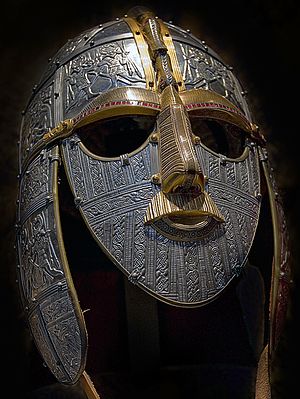Anglo-Saxon England
Anglo-Saxon England or Early Medieval England covers the period from the end of Roman Britain in the 5th century until the Norman Conquest in 1066. It consisted of various Anglo-Saxon kingdoms until 927, when it was united as the Kingdom of England by King Æthelstan (r. 927–939). It became part of the short-lived North Sea Empire of Cnut, a personal union between England, Denmark and Norway, in the 11th century. The Anglo-Saxons migrated to Britain from mainland northwestern Europe after the Roman Empire's withdrawal from Britain at the beginning of the 5th century. Anglo-Saxon history thus begins during the period of sub-Roman Britain following the end of Roman control, and traces the establishment of Anglo-Saxon kingdoms in the 5th and 6th centuries (conventionally identified as seven main kingdoms: Northumbria, Mercia, East Anglia, Essex, Kent, Sussex, and Wessex); their Christianisation during the 7th century; the threat of Viking invasions and Danish settlers; the gradual unification of England under the Wessex hegemony during the 9th and 10th centuries; and ending with the Norman Conquest of England by William the Conqueror in 1066. The Normans persecuted the Anglo-Saxons and overthrew their ruling class to substitute their own leaders to oversee and rule England. However, Anglo-Saxon identity survived beyond the Norman Conquest, came to be known as Englishry under Norman rule, and through social and cultural integration with Romano-British Celts, Danes and Normans became the modern English people. (Full article...) Selected articleThe Staffordshire Hoard is the largest hoard of Anglo-Saxon gold and silver metalwork yet found[update]. Discovered in a field near the village of Hammerwich, near Lichfield, in Staffordshire, England on 5 July 2009, it consists of over 3,500 items that are nearly all martial in character, and contains no objects specific to female uses. Artefacts have tentatively been dated to the 7th or 8th centuries, placing the origin of the items in the time of the Kingdom of Mercia. Experts have produced a range of theories as to where the hoard came from and how it came to be deposited, and whether the objects were made for Christians or pagans. The average quality of the workmanship is extremely high, and especially remarkable in view of the large number of individual objects, such as swords or helmets, from which the elements in the hoard came. The hoard was valued at £3.285 million, and has now been purchased by the Birmingham Museum & Art Gallery and the Potteries Museum & Art Gallery. (more...) Did you know?
SubcategoriesSelected image Sutton Hoo, near Woodbridge, in Suffolk, is the site of two 6th- and early 7th-century cemeteries. One contained an undisturbed ship burial including a wealth of Anglo-Saxon artefacts of outstanding art-historical and archaeological significance, now held in the British Museum in London. Selected biographyIne was King of Wessex from 688 to 726. He was unable to retain the territorial gains of his predecessor, Cædwalla, who had brought much of southern England under his control and expanded West Saxon territory substantially. By the end of Ine's reign the kingdoms of Kent, Sussex and Essex were no longer under West Saxon domination; however, Ine maintained control of what is now Hampshire, and consolidated and extended Wessex's territory in the western peninsula. Ine is noted for his code of laws (Ine’s laws or laws of Ine), which he issued in about 694. These laws were the first issued by an Anglo-Saxon king outside Kent. They shed much light on the history of Anglo-Saxon society, and reveal Ine's Christian convictions. Trade increased significantly during Ine's reign, with the town of Hamwic (now Southampton) becoming prominent. It was probably during Ine's reign that the West Saxons began to mint coins, though none have been found that bear his name. Ine abdicated in 726 to go to Rome, leaving the kingdom to "younger men", in the words of the contemporary chronicler Bede. He was succeeded by Æthelheard. (more...) Things you can do
Featured articles and lists
Related portalsWikiProjects
Associated WikimediaThe following Wikimedia Foundation sister projects provide more on this subject:
| |||||||||||||||||












